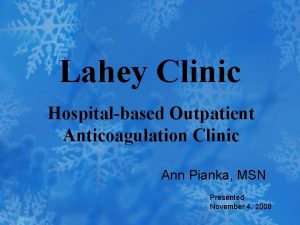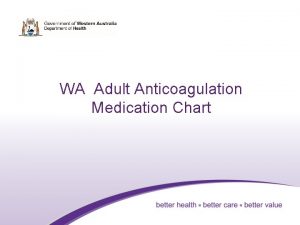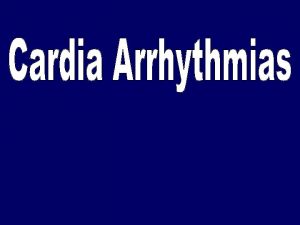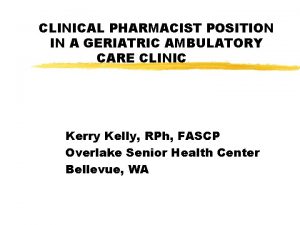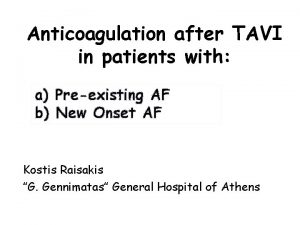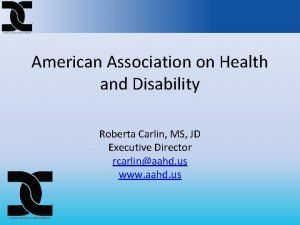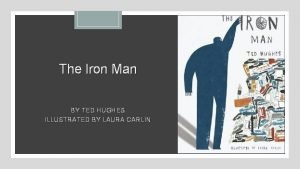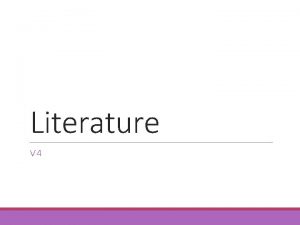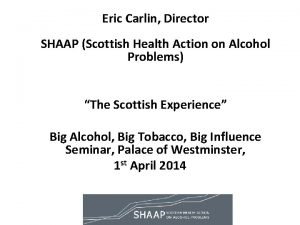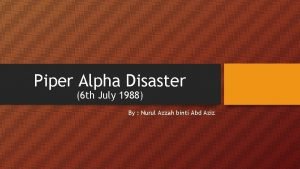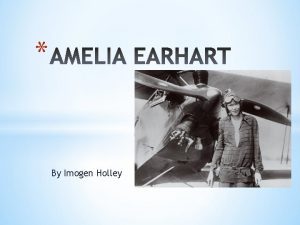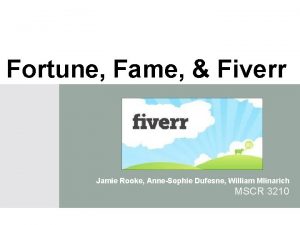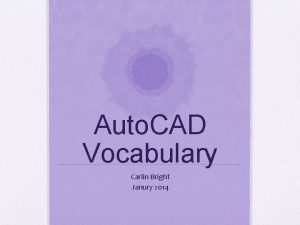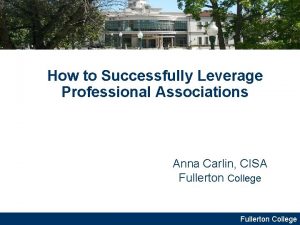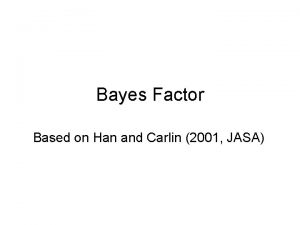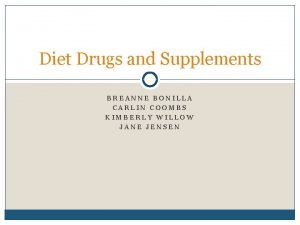Introduction to Anticoagulation Carlin Rooke MD July 27


















































- Slides: 50

Introduction to Anticoagulation Carlin Rooke, MD July 27, 2018

Pain Scale Jeopardy Discomforting Distressing Intense Utterly horrible $100 $200 $300 $400 Final Jeopardy

Level 1: Discomforting

Level 2: Distressing

Level 3: Intense

Level 4: Utterly Horrible

$100 – Clinic Referrals What is the correct way to refer a patient to anticoagulation clinic?

What is the correct way to refer a patient to anticoagulation clinic? a) ORCHID message to Dr. Rooke b) ORCHID message to Coumadin message pool c) Send a carrier pigeon to room 2 D-152 d) Phone or page Dr. Rooke directly



OVM Coumadin ED/UC Urgent Follow Up


$100 – starting warfarin When starting warfarin in the outpatient setting: - What is the usual starting dose? - How much medication should be provided?

When starting warfarin in the outpatient setting: - What is the usual starting dose? - How much medication should be provided? Starting Dose: Supply: a) b) c) d) 1 mg 2. 5 mg 10 mg 3 days 10 -14 days 30 days 90 days

$100 – Access to DOACs Which insurance status prevents a patient from access to rivaroxaban and/or apixaban at the OVMC pharmacy?

Which insurance status prevents a patient from accessing rivaroxaban and/or apixaban at the OVMC pharmacy? a) DHS Medi-Cal Managed Care b) IHSS (In-Home Supportive Services) c) Non-DHS Medi-Cal Managed Care d) ATP/Charity e) None of the above

Prior Authorization


$200 – Surgically provoked DVT If a patient develops a DVT within 3 months of having major surgery, what is the most appropriate treatment?

If a patient develops a DVT within 3 months of having major surgery, what is the most appropriate treatment? a) b) c) d) d) e) Rivaroxaban for 3 months Rivaroxaban for 6 months Rivaroxaban indefinitely Warfarin for 3 months (with initial lovenox bridging) Warfarin for 6 months (with initial lovenox bridging) Warfarin indefinitely (with initial lovenox bridging)

Risk of recurrent VTE after surgically-provoked VTE 1 yr Surgical provoking 1% factor 5 yrs (0. 5%/yr)

$200 – Nonvalvular AFib Which of the following patients must be treated with warfarin, (not rivaroxban or apixaban)?

Which of the following patients must be treated with warfarin (not rivaroxaban or apixaban)? a) 47 Y W with paroxysmal Afib and moderate mitral stenosis b) 64 Y M with permanent Afib and aortic sclerosis c) 75 Y M with paroxysmal Afib and mitral valve prolapse

Valvular Atrial Fibrillation 1. Inconsistent definition, but always includes: a) Mitral valve stenosis b) Rheumatic heart disease 2. Warfarin is superior to DOAC therapy

$200 – Malignancy-associated VTE A patient is found to have a DVT of her left popliteal vein. She is also receiving chemotherapy and radiation for cervical cancer. What is the most effective anticoagulant?

What is the most effective anticoagulant for treating malignancy-associated DVT? a) b) c) d) Lovenox Warfarin (with initial lovenox bridge) Rivaroxaban or apixaban IV unfractionated heparin

Recurrence of VTE with malignancy • CLOT trial warfarin (17%) vs dalteparin (9%) • LITE trial warfarin (16%) vs tinzaparin (7%) • No data for novel oral anticoagulants

$300 – New onset Afib A 54 year old man with hypertension presents to his primary care appointment. He feels well. On physical exam, he is found to have an irregularly irregular heart rate. EKG confirms atrial fibrillation with rate of 84 bpm. What is the best strategy for anticoagulation?

What is the best anticoagulation strategy for this patient’s new onset atrial fibrillation? a) Start oral rivaroxaban (and refer to anticoagulation clinic) b) Start oral warfarin (and refer to anticoagulation clinic) c) Prescribe oral warfarin with lovenox bridging (and refer to anticoagulation clinic) d) Admit to hospital for warfarin with IV unfractionated heparin bridging (and refer to anticoagulation clinic at discharge)

When does new onset atrial fibrillation require lovenox or heparin? Patient is not a candidate for DOAC, and 1. Electric cardioversion is planned/desired Absolute indications 2. Cardiac thrombus is present 3. Patient requires amiodarone (potential for chemical cardioversion) Debatable 4. Patient has very high CHADSVASC score (6 indications 8? ) 5. Patient has known valvular heart disease

$300 – New Onset AFib A 50 year-old woman with hypertension and latent TB infection presents to a regular primary care appointment. On physical exam, she is found to have an irregularly irregular heart rate. EKG confirms atrial fibrillation with a rate in the 70’s. Her medications include amlodipine for hypertension and isoniazid/rifampin for latent TBI. What is the best anticoagulation strategy for this patient?

What is the best anticoagulation strategy for this patient’s new onset atrial fibrillation? a) Start oral rivaroxaban (and refer to anticoagulation clinic) b) Start oral warfarin (and refer to anticoagulation clinic) c) Prescribe oral warfarin with lovenox bridging (and refer to anticoagulation clinic) d) Admit to hospital for warfarin with IV unfractionated heparin bridging (and refer to anticoagulation clinic at discharge)

Beware drug-drug interactions with Xa inhibitors Dual inhibitors of CYP 450 (3 A 4) and P-glycoprotein • • • • Boceprevir Clarithromycin Cobicistat Conivaptan Darunavir Indinavir Itraconazole Ketoconazole Lopinavir Nelfinavir Nicardipine Posaconazole Ritonavir Saquinavir Telaprevir Telithromycin Strong CYP 450 (3 A 4) Inducers • • • Carbamazepine Enzalutamide Fosphenytoin Nevirapine Oxcarbazepine Pentobarbital Phenytoin Primidone Rifabutin Rifampin Rifapentine

More efficient “brain storage” Dual inhibitors of CYP 450 (3 A 4) and P-glycoprotein Strong CYP 450 (3 A 4) Inducers ID Drugs (especially HIV and antifungal) TB drugs and antiepileptics

What is the cost to DHS for one year of outpatient rivaroxaban therapy for one patient? a) b) c) d) e) $1100 $4000 $5500 Depends on the patient’s insurance status Depends on where the medication is prescribed (ie: OVMC vs Mid Valley) f) Depends on which pharmacy the patient uses (ie: DHS vs non-DHS)

$300 – Acute DVT A 32 year old man presents to the ED with two days of warmth, swelling, and tenderness of his right calf and thigh. Ultrasound shows a DVT of the right femoral and popliteal veins. He has no known medical problems, and he takes no medications. No recent surgeries or immobilization. He is started on subcutaneous lovenox and warfarin. How long should warfarin and lovenox be continued?

Treatment with warfarin for acute, unprovoked DVT Duration of lovenox Duration of warfarin 1. 5 days 1. 3 months, then stop 2. Until INR is 2. 3 months, then have therapeutic a risk/benefit discussion with the 3. 5 days and until INR is patient therapeutic 3. 6 months, then stop 4. Indefinite

“Overlap” versus “Bridging” Overlap therapy refers to: The use of a parenteral anticoagulant (e. g. lovenox, IV heparin), in combination with warfarin, to provide immediate anticoagulation for an acute DVT or PE Bridging refers to: The use of a short-acting anticoagulant (e. g. lovenox, IV heparin) to maintain anticoagulation when a patient’s warfarin needs to be interrupted (usually for a procedure)

ACCP Guidelines Low Moderate High Bleeding Risk Provoked, Surgical 3 months Provoked, Non-surgical 3 months Unprovoked Indefinite 3 months WEAK STRONG

$400 – IV heparin protocols Which IV heparin protocol (ACS or DVT/PE) should be used for each clinical indication listed below? 1. Acute NSTEMI 2. Unstable angina 3. New onset Afib requiring heparin bridge 4. Acute DVT 5. Perioperative bridging for a patient who has a history of recurrent DVT/PE’s 6. Perioperative bridging for a patient with a mechanical mitral valve

Which IV heparin protocol (ACS or DVT/PE) should be used for each clinical indication? 1. 2. 3. 4. 5. Acute NSTEMI ACS Unstable angina ACS New onset Afib requiring heparin bridge Acute DVT/PE Perioperative bridging for a patient who has a history of recurrent DVT/PE’s 6. Perioperative bridging for a patient with a mechanical mitral valve ACS ACS

IV heparin protocols: AFib vs DVT/PE • Both protocols target the same a. PTT range • DVT/PE protocol has a larger bolus (80 units/kg) and larger initial infusion rate (18 units/kg/hr) • Patient should become therapeutic faster • More likely to have critically high a. PTT and/or bleeding • ACS protocol has a smaller bolus (60 units/kg) and smaller initial infusion rate (12 units/kg/hr) • May take longer to become therapeutic • Less bleeding risk Take-home point: use the DVT/PE protocol only when it is critical that the patient be therapeutic as quickly as possible

$400 – Provoking Factors Name at least five (non genetic) conditions that are considered provoking factors for DVT/PE

Major and minor provoking factors… Major • Surgery in the past 3 mos • Malignancy Minor (within 6 weeks of DVT): • General anesthesia • Estrogen use • Pregnancy or post-partum (up to 3 mos) • Non-stop flight > 8 hrs • (Bed-bound x 1 d or chair bound x 3 d)*

Recurrence of VTE 1 yr Surgical provoking 1% factor 5 yrs (0. 5%/yr) Non-surgical provoking factor* 5% (2. 5%/yr) Unprovoked 10% 30% *Within 6 weeks of VTE: General anesthesia Flight > 8 hrs Injury that significantly limits mobility Bed-bound x 1 day Pregnancy or post-partum period (up to 3 mos) Estrogen tx

(Utterly Horrible) Daily Double

Lightening Quiz: True/False (Write down your answers) FALSE TRUE FALSE TRUE 1. Referrals should be submitted to the pool “OVM – Coumadin – Nursing” 2. Patients should be prescribed a minimum 30 day supply of warfarin, to prevent running out 3. Usual initial dose of warfarin is 5 mg 4. Any DHS patient (regardless of insurance) can obtain rivaroxaban if it is clinically indicated 5. A surgically-provoked DVT should be treated for 3 months 6. A patient with atrial fibrillation and mitral stenosis can be treated with either warfarin or rivaroxaban 7. Lovenox is the preferred treatment for malignancy-associated DVT

Lightening Quiz: True/False (Write down your answers) FALSE TRUE FALSE 8. Patients found to have atrial fibrillation in the outpatient setting usually require immediate anticoagulation with lovenox or IV heparin 9. Rivaroxaban/Apixaban can be safely used with most tuberculosis and anti-epileptic medications 10. An unprovoked DVT should be treated for a minimum of 3 months 11. “Bridging” refers to the use of lovenox or IV heparin (in combination with warfarin) for the treatment of an acute DVT or PE 12. The DVT/PE heparin protocol should be used when a patient requires perioperative bridging for old/chronic thromboembolic events.

Knowing when to ask for guidance:

When to ask for guidance: • Patient requires dual antiplatelet therapy and anticoagulation • Patient needs outpatient perioperative bridging • Use of apixaban and rivaroxaban in patients with borderline or poor renal function
 Lahey coumadin clinic
Lahey coumadin clinic Tripple therapy
Tripple therapy Warfarin dosing chart
Warfarin dosing chart Coumadin clinic emory
Coumadin clinic emory Anticoagulation
Anticoagulation Classification of antiarrhythmic drugs
Classification of antiarrhythmic drugs Overlake anticoagulation clinic
Overlake anticoagulation clinic Anticoagulation
Anticoagulation Wa anticoagulation chart
Wa anticoagulation chart George carlin philosophy for old age
George carlin philosophy for old age Roberto carlin
Roberto carlin American association on health and disability
American association on health and disability Carlin
Carlin The iron man description
The iron man description Anna carlin
Anna carlin George carlin football versus baseball
George carlin football versus baseball Cuántos años tiene george carlin
Cuántos años tiene george carlin The iron man laura carlin
The iron man laura carlin George carlin philosophy
George carlin philosophy George carlin türkçe
George carlin türkçe George carlin irony
George carlin irony Eric carlin
Eric carlin Another place another time harris burdick
Another place another time harris burdick Harris burdick pictures uninvited guest
Harris burdick pictures uninvited guest July 1-4 1863
July 1-4 1863 Tender definition
Tender definition Astronomy picture of the day 11 july 2001
Astronomy picture of the day 11 july 2001 2001 july 15
2001 july 15 2003 july 17
2003 july 17 July 30 2009 nasa
July 30 2009 nasa Sources nso july frenchhowell neill technology...
Sources nso july frenchhowell neill technology... What is the significance of july 4 1776 brainpop
What is the significance of july 4 1776 brainpop Sylvia plath poppies in july
Sylvia plath poppies in july Hurrah for the fourth of july cartoon
Hurrah for the fourth of july cartoon Imagery in poppies in july
Imagery in poppies in july Gdje se rodio nikola tesla
Gdje se rodio nikola tesla Ctdssmap payment schedule july 2021
Ctdssmap payment schedule july 2021 Sergei korolev
Sergei korolev 6th july 1988
6th july 1988 Monday 13th july
Monday 13th july On july 18 2001 a train carrying hazardous chemicals
On july 18 2001 a train carrying hazardous chemicals July 4 sermon
July 4 sermon June too soon july stand by
June too soon july stand by July 2 1937 amelia earhart
July 2 1937 amelia earhart June 22 to july 22
June 22 to july 22 July 12 1776
July 12 1776 Sensory language definition
Sensory language definition Catawba indian nation bingo
Catawba indian nation bingo January february march april may june july august
January february march april may june july august July 14 1789
July 14 1789 Malaga in july
Malaga in july
